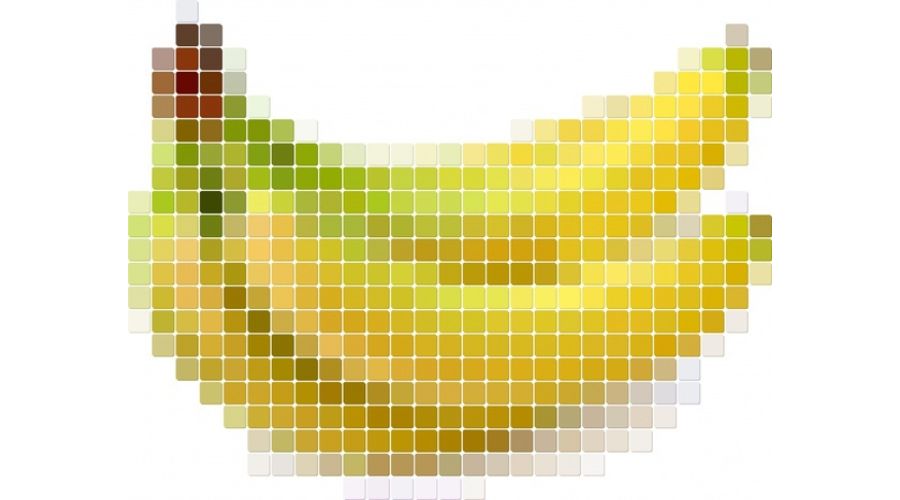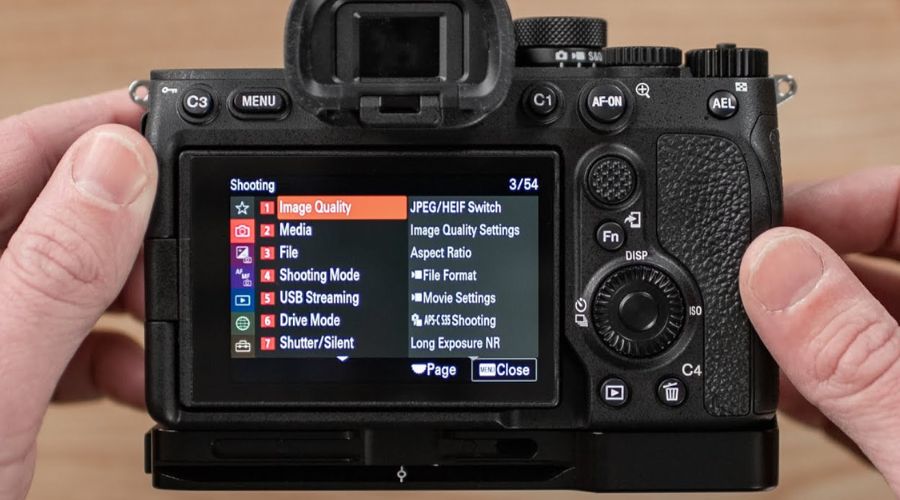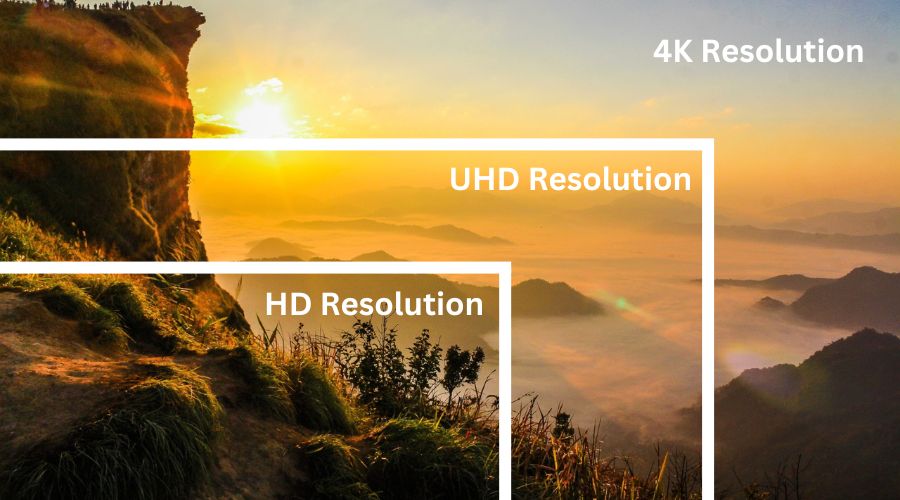Breaking Down Camera Resolution
When you’re trying to get a grip on camera resolution and megapixels, think of your camera as a starry-eyed artist keen to paint as many dots of color as possible onto your image canvas.
More dots, or pixels, means a sharper, more detailed picture—kind of like how a baker can make a cake super fancy with lots of tiny icing details.
Simple enough, right?
Difference Between Image Resolution and Display Resolution
Now, don’t mix up image resolution with display resolution. You might think they’re two peas in a pod, but they’re more like distant cousins.
Image resolution is all about the detail your camera captures.
Display resolution? That’s the number of dots your screen shows.
Imagine having a zillion crayons for a drawing, but if your paper is the size of a postage stamp, you’ll only see a fraction of those colors. That’s the gist of it.
Understanding Resolution Specifications
Let’s talk turkey.
When you peep those specs on a camera’s box, you’ll see something like ’12MP’. That’s short for megapixels, and it’s telling you that your camera captures 12 million tiny dots of color.
It’s like saying your pickup truck can haul 12 million jellybeans in one go—quite the haul!
Standard Resolution Measurements in Cameras
Get this: standard resolutions in cameras range from the good ol’ 2MP (mega quaint) to a whopping 50MP or more (mega magnificent).
Think of these like buckets that hold your picture-pixels. A bigger bucket means more room for details, like how a birthday card has more space for signatures than a sticky note.
Keep your eyes peeled for phrases like ‘Full HD’, ‘4K’, and ‘8K’, as they’re the big guns in the resolution showdown, offering you crisper and more jaw-dropping images.
Time to click and marvel at your pixel-packed masterpieces!
The Role of Megapixels in Camera Resolution
When you dive into the world of photography, one term pops up like a jack-in-the-box: megapixels.
Understand camera resolution and megapixels, and you’re on your way to snapping pics like a pro.
But remember, more isn’t always merrier when it comes to these pixel-packed numbers.

What is a Megapixel and How is it Calculated?
Just like I said, a megapixel is like one million tiny puzzle pieces that make up your picture.
Basically, if your camera boasts 12 megapixels, you’ve got 12 million little dots of color playing nice together to create your image.
Simply put, imagine a grid of horizontal and vertical lines, count every box where they intersect, and – bam! – you’ve got your megapixel count.
It’s just simple math that makes your photos tick.
How Many Megapixels Do You Really Need?
Here’s the skinny: unless you’re planning on wallpapering your house with your selfies, you might not need a bazillion megapixels.
For most snapshots and social media posts, even smartphones with 8-12 megapixels will knock your socks off.
If you’re printing your photos, holding steady at 16-20 megapixels should cover all your bases without breaking the bank on data storage.
Megapixels vs. Sensor Size
Imagine you’re at a party where the room size stays the same but more guests keep piling in. That’s kind of like stuffing more megapixels onto a tiny sensor – things get crammed.
Bigger sensors with the right amount of megapixels are the life of the party, making your photos clearer, brighter, and with less noise—like the cool uncle who brings the good snacks.
So remember, it’s not just the megapixels bringing the magic; a roomy sensor size can make or break your photo fiesta.
So gear up, take aim, and shoot for the stars – just make sure those stars aren’t too pixel-packed for your camera party!
Comparing Camera Resolutions
So, you’ve decided to snap up a new camera. Good for you!
Now, let’s talk about something that will make your head spin – camera resolution and megapixels.
Trust me, it’s a piece of cake once you get the hang of it.

Entry-Level, Prosumer, and Professional Cameras
It’s like comparing apples, oranges, and bananas. Entry-level cameras are the apples.
They’re sweet and straightforward with resolutions often ranging from 10 to 16 megapixels. Good enough for your everyday shots.
Prosumer cameras – those are your oranges. A bit zesty with more kick and resolutions from 16 to 24 megapixels. They give your photos that extra oomph.
Lastly, the bananas: professional cameras. With over 24 megapixels, they’re top banana for magazine-quality images.
Don’t get your knickers in a twist over numbers, though. Remember, more megapixels don’t always mean a better picture. It’s like having a bigger blanket; it covers more ground but isn’t necessarily cozier.
Understanding Resolution in Smartphone Cameras
Now, let’s chat about the camera you always have on you – your smartphone.
These gadgets have been giving traditional cameras a run for their money.
With resolutions climbing up the megapixel ladder, even your phone could pack a 12-megapixel or higher punch.
But let’s not count our chickens before they hatch. These pixels might be more packed together than sardines, leading to digital noise in low light.
So, while you can brag about the high megapixel count on your phone, sometimes the photos turn out like a Jackson Pollock painting, a bit too abstract for your liking.
Interpreting Camera Resolution Specifications
Cut through the technical mumbo-jumbo of camera resolution like a hot knife through butter. Here’s the skinny: megapixels are millions of tiny dots that make up your picture.
More dots usually mean a sharper, more detailed photo, like noticing the individual sprinkles on a donut.
But – and it’s a big but – cramming more megapixels onto a small sensor could make your photos look worse than a dog’s dinner in low light.
So, don’t chase megapixels like a dog chasing its tail. Look for the sweet spot that fits your shooting style and, most importantly, keeps your photos looking peachy.
Let this sink in, and your journey through the thicket of camera resolutions and megapixels will be as easy as pie.
Resolving the Megapixel Myth
When you dive into the nitty-gritty of camera resolution and megapixels, you might hear a whisper down the grapevine that more megapixels guarantee top-notch photos.
But let’s not count our chickens before they hatch—this isn’t the full picture! Let’s peel back the layers of this widely believed idea.
The Myth of More Megapixels Equals Better Quality
Have you ever believed that a camera with more megapixels was the be-all and end-all for high quality snaps?
Well, hold your horses!
It turns out that megapixels are just one piece of the puzzle. A camera’s resolution tells you how many pixels are in an image, and yes, while having a lot of them can add detail, it doesn’t automatically mean your pictures will be as sharp as a tack.
It’s a bit like assuming a bigger dog has a louder bark—size isn’t everything!
Factors That Affect Image Quality Beyond Megapixels
Think of your camera as a mini wizard. It needs more than just a high megapixel count to whip up stunning images.
The sensor size is like the wizard’s cauldron, brewing up all the fine details.
And the quality of the lens? That’s the magic wand, focusing all the good stuff into a crystal-clear photo.
Remember, even if you have a camera boasting more megapixels than stars in the sky, if the sensor and lens are of poor quality, your images might still come out looking like they’ve been through a hedge backward.
Optimal Megapixel Counts for Various Usages
So, what’s the magic number of megapixels for snapping everything from your cat’s mischief to grand landscapes?
For everyday shots and social media, a camera with 8-12 megapixels is like hitting the bullseye.
Want to print your photos? Aim for 10-20 megapixels to keep the image from fuzzing out like a television on the fritz.
And if you’re all about billboard-sized prints, or cropping photos like a pro gardener trims bushes, then 20 megapixels and beyond will be your sweet spot.
In summary, don’t get caught up in the megapixel hype train without considering the whole shebang. Balance those pixels with a good sensor and sharp lens, and you’ll be cooking with gas.
Remember, a painter needs more than just a big canvas to create a masterpiece!
Optimizing Camera Settings for Maximum Resolution
Now, it’s time for the trick to fiddle with your camera settings. Jack those numbers up, and voilà, you’re on the express train to Crispville.
But don’t crank it all the way without a thought; that’s like pouring syrup on a pancake with a hole in the middle — it can get messy.

Adjusting Resolution Settings in Your Camera
You’ve got a snazzy camera in your hands; it’s time to make it sing your tune.
Dive into the settings menu like a pirate hunting for treasure. Spot that ‘Resolution’ setting? That’s your golden doubloon. Adjust it to the max, like spinning your office chair until you hit the sweet spot.
It’s the high numbers that give your photos the sharpness of cheddar that’s been aging longer than a wizard.
Impact of File Formats on Resolution (JPEG vs. RAW)
Okay, picture this — you’ve just ordered the deluxe burger of photos: the RAW file.
It’s like keeping the kitchen sink when you move houses — everything’s in there.
Now, JPEG is like a burger that’s already been chewed a bit — still good, but a little mushy.
Go RAW for the full Monty, and JPEG when you need to travel light, but remember, a hefty file can make your storage cry uncle.
Understanding the Balance Between Resolution and File Size
It’s a seesaw, really. Jack up the resolution, and your file size puffs up like a blowfish. Your camera’s storage will fill up faster than a bathtub with the tap left on.
Keep it as a dance between quality and quantity.
You want the crispiest picture, but don’t let file size bully you into buying a dozen more memory cards. It’s about striking harmony, like a seesaw that doesn’t bang down hard enough to launch your buddy into space.
Wrapping your mind around camera resolution and megapixels doesn’t need to be tougher than a two-dollar steak. Just spin those dials, choose the right file format, and balance that tightrope between resolution and file size.
Advancements in Camera Resolution Technology
Let’s dive into the nitty-gritty of camera resolution and what those megapixels really mean for your snapshots.
Looking back, it seems like ages ago when the camera world was thrilled over breaking the one-megapixel barrier.
Fast forward to today, and boy, we’ve come a long way!
How Camera Resolution Has Evolved
Picture this: in the early days, digital cameras with a measly 1MP sensor were the bee’s knees. Now, your smartphone probably scoffs at anything less than 12MP.
As camera resolutions grew, so did our expectations for crystal-clear photos.
And let’s be real, who doesn’t want their selfies to be sharper than a tack?
So, you’ve got these beefy cameras in your pockets, outdoing many old-school cameras without breaking a sweat.
But hold your horses; it’s not all about chasing megapixels. After all, even a million megapixels can’t save a photo if the lighting’s bad—talk about a shot in the dark!
Future Trends in Camera Resolution and Megapixel Counts
As for what’s next in the universe of camera tech?
Think megapixels on steroids. We’re talking about numbers that’ll make your head spin.
But remember, as i said, more megapixels doesn’t always mean better pictures. It’s like having a powerful car; you gotta know how to handle it.
Yet the trend seems to be that bigger is better, so don’t be surprised if your next phone has enough megapixels to see the ants marching.
Still, it’s not about plastering your photos on a billboard. You’re probably sharing them on social media where they’re shrunk down anyway.
So, don’t be fooled by the megapixel race; often, it’s the wizardry behind the lens that counts.
The Role of Software in Enhancing Camera Resolution
You’ve got hardware doing the heavy lifting, but don’t overlook the magic of software. These days, it’s all about algorithms that sprinkle fairy dust on your pics.
Imagine software being the fairy godmother to your Cinderella, making your ordinary snapshots the belle of the ball.
Software sharpening tools can make a blurry tree look like it’s got every leaf drawn with a fine pen. So, while you’re swiping away at camera specs, give a nod to the software that’s pulling rabbits out of hats, making your photos pop.
Farewell, Photo Fanatics!
We’ve journeyed through the pixels and dipped our toes into the pool of camera resolution.
To understand camera resolution and megapixels is like mastering the ABCs of photography – essential but just the start. You’ve learned that more megapixels can make your pictures crisper than a golden apple in autumn, but it’s not the whole pie.
Remember, a high number of megapixels is a feather in your cap, but it’s not a magic wand. It’s like having a fast car; it’s great on the open road but in a traffic jam? Not so much.
Your image quality also depends on how good your lens is, the sensor size, and your photography skills. Mix those ingredients well, and you’re on your way to capturing memories sharper than a tack.
By now, you should know that camera resolution and megapixels are important, but they’re not the be-all and end-all.
Like finding the right pair of jeans, it’s all about what fits your needs best.
So keep snapping, keep learning, and don’t be afraid to click outside the box. And hey, if your photos turn heads or even just make Grandma smile, you’re already a star in our book!
Frequently Asked Questions
What exactly are megapixels, and why do they matter for my camera?
What exactly are megapixels, and why do they matter for my camera?
Think of megapixels like buckets of color your camera uses to paint a picture. More buckets, more detail. A megapixel equals one million tiny dots in your photo. The more you have, the crisper and more detailed your picture is likely to be. They’re important because they help your photos look sharp, even when you zoom in.
Is a higher megapixel count always better?
You might think so, but it’s like fishing with a net – bigger isn’t always better. Sure, more megapixels can catch more details, but you also need a good lens and proper lighting. Plus, too many megapixels can make your files huge, and nobody wants to fill their memory card after taking just a few shots.
How many megapixels do I need for quality prints?
Gone are the days of grainy prints that look like they’ve been through the ringer. For a decent 4×6 print, you’ll want at least 3 megapixels. But if you’re looking to cover your wall with a beautiful landscape, aim for 10 megapixels or more to keep everything looking sharp.
What’s the deal with camera resolution?
Camera resolution is like the number of seats in a theater. The more there are, the bigger the crowd it can hold. In camera talk, it’s the total number of pixels that fit onto your photo. More pixels mean a larger and clearer image, like sitting front row at your favorite show.
Do I need a high-resolution camera for social media photos?
Not really. Social media compresses photos like a suitcase packed for a weekend trip. You only need enough resolution to look good on phones and computer screens. Around 5 megapixels should do the trick unless you’re shooting for billboard-sized fame.
Will more megapixels help me in low-light conditions?
More megapixels are like having more eyes in the dark – it doesn’t necessarily mean you’ll see better. What you need is a camera that can let in more light, much like night vision goggles. It’s the sensor size and quality that’ll give you clearer shots when the lights are low, not just the megapixel count.
Can I judge a camera’s quality just by megapixels alone?
That would be like saying a car is fast just because it’s red. Megapixels tell part of the story, sure, but you also need to consider other parts like the sensor, lens, and image processor. It’s the whole team that makes your photos worthy of a place on the fridge.

